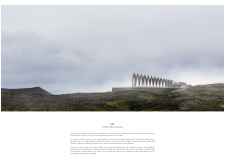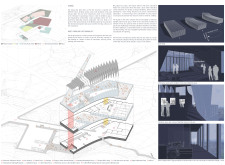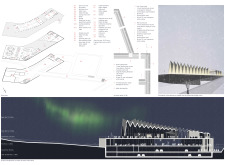5 key facts about this project
The Iceland Volcano Museum is located in the Mývatn region of Iceland, a place known for its dramatic landscapes of glaciers and volcanic formations. The museum serves to inform and engage visitors about the unique geological history of the area. The design concept integrates the building within the natural environment, reflecting a deep respect for the surrounding landscape while providing an educational experience.
Concept and Integration
The design of the Iceland Volcano Museum takes inspiration from Hallgrímskirkja, a well-known cathedral that stands tall and connects with its surroundings. This influence is seen in the museum's overall shape, which blends into the contours of the Mývatn terrain. By thoughtfully considering the site, the design seeks to reduce environmental impact and enhance the enjoyment of the scenic beauty that Iceland offers.
Spatial Organization
The layout of the museum is organized into distinct layers that maximize both views and natural light. This arrangement finds inspiration in the artwork of Icelandic artist Steinunn Eik, who captures the essence of volcanic landscapes in her layered paintings. Organizing the space across multiple levels encourages visitors to move through the exhibits while remaining connected to the breathtaking outdoor scenery.
Material Composition
Materials play an important role in the museum's design. Cross-laminated timber is used as the main structural element, recognized for its strength and aesthetic value. This choice supports sustainable building practices while creating a warm atmosphere within the museum. The exterior is clad in chiseled lava stone, deepening the connection to Iceland's volcanic history and making it relevant to the natural surroundings.
Natural Light and Views
The design emphasizes the use of natural light, with careful planning to ensure that daylight flows through the museum. The building is tilted and oriented toward the east and south, which allows sunlight to fill the spaces while offering clear views of the Hverfjall volcano. This orientation enhances the experience for visitors, providing a strong link between the museum and the significant geological features nearby.
The project incorporates exposed structural elements that highlight the authenticity of the design. Visitors can appreciate the relationship between the architecture and the landscape, creating an environment that fosters engagement with the natural world. The use of cross-laminated timber inside creates a connection that invites people to reflect on the beauty of both the exhibits and the surrounding landscape.

























































